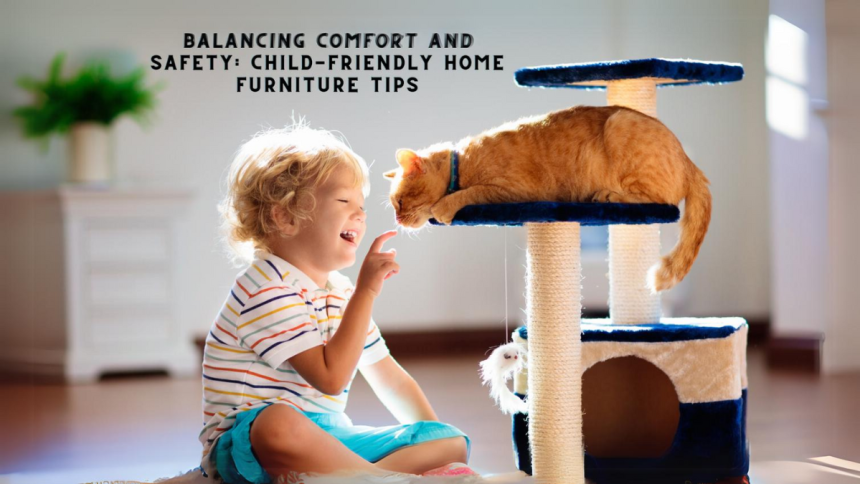Creating a safe and comfortable home environment for children is a top priority for parents. As little ones explore their surroundings, it’s crucial to ensure that the furniture in your home is both inviting and secure. This blog will walk you through essential tips for selecting and arranging child-friendly furniture, helping you create a space that’s both functional and safe for your family.
Essential Safety Features for Kid-Friendly Furniture
When it comes to furnishing a child-friendly home, safety should be your primary concern. Let’s explore the key features to look for when choosing furniture for your little ones.
Sharp corners commonly cause injuries in the home. To minimize this risk, prioritize furniture with rounded edges and corners. This simple design feature can significantly reduce the chances of bumps and bruises as your child navigates their space.
According to a study, rounded edges on furniture can decrease the severity of injuries from falls. Tall furniture pieces such as bookshelves and dressers pose a tipping hazard. Always anchor these items securely to the wall. This precaution is crucial, as furniture tip-overs can cause serious injuries or even fatalities.
- Use sturdy wall straps or brackets
- Install anti-tip kits on all tall furniture
- Place heavier items on lower shelves
Opt for Non-Toxic Materials
Children’s health is paramount, so choose furniture made from non-toxic materials. When considering safe and durable options for your child’s room, American made furniture often stands out for its quality and adherence to strict safety standards.
These pieces not only support local economies but frequently offer better customization options to suit your specific needs. Look for:
- Solid wood furniture
- Low VOC (Volatile Organic Compounds) materials
- Formaldehyde-free options
Did you know? The demand for eco-friendly children’s furniture has grown by 15% in the past year, reflecting parents’ increased awareness of the importance of non-toxic materials.
Preventing Climbing Accidents
Choose furniture that’s appropriately sized for your child. This promotes comfort and discourages climbing, which can lead to accidents.
- Ensure chairs and tables are the right height
- Use step stools for accessing higher areas safely
- Consider adjustable furniture that grows with your child.
Practical Tips for Enhancing Furniture Safety
Now that we’ve covered the essential features, let’s look at some practical ways to further improve the safety of your home furniture.
Secure Placement of TVs and Heavy Objects
Flat-screen TVs pose a tipping hazard. Mount them securely to the wall whenever possible. For other heavy objects:
- Place them on lower shelves
- Use non-slip mats under items on higher surfaces
- Avoid placing tempting objects where children might climb to reach them
Protective Additions
Despite careful furniture selection, you can add extra protection:
- Install corner guards on sharp edges.
- Use edge protectors on table sides
- Apply cushioned covers to hard surfaces.
These simple additions can make a big difference in preventing injuries from everyday bumps and falls.
Child Engagement and Comfort in Furniture Choice
Safety does not mean sacrificing fun or comfort. Combining elements like vibrant colors and playful designs can make the space inviting for kids, encouraging them to engage in fun activities to do at home.
By thoughtfully selecting and arranging furniture, you can create a harmonious blend of safety, comfort, and enjoyment for your children. Let’s explore making furniture choices that engage and delight your children.
Interactive and Personalize Furniture
Incorporate elements that inspire joy and creativity:
- Themed beds (e.g., treehouse or castle designs)
- Chairs with built-in storage for toys
- Desks with integrated chalkboards or whiteboards
Children’s rooms with interactive furniture elements see 25% more playtime, encouraging creativity and independent play.
Customize Your Furniture
Involving your child in furniture selection can help them feel more connected to their space:
- Allow them to choose colors or patterns
- Consider furniture with customizable elements.
- Incorporate their favorite characters or themes
This personal touch not only makes the space more inviting but also instills a sense of responsibility in your child for their environment.
Long-term Thinking in Furniture Selection
Investing in furniture that grows with your child can save money and reduce waste over time.
Adaptable Furniture
Look for pieces that serve multiple purposes or can be adjusted as your child grows.
- Cribs that convert to toddler beds
- Desks with adjustable heights
- Expandable storage solutions
Quality and Durability
Choosing high-quality, durable furniture is both cost-effective and safer in the long run:
- Opt for solid construction over particleboard
- Look for reinforced joints and sturdy hardware
- Consider materials known for longevity, like hardwoods
| Furniture Type | Average Lifespan | Tips for Longevity |
| Solid Wood Desk | 10-15 years | Regular polishing, avoid direct sunlight |
| Convertible Crib | 5-10 years | Use as intended, regular tightening of screws |
| Upholstered Chair | 7-10 years | Rotate cushions, professional cleaning |
| Plastic Storage | 5-7 years | Avoid overloading, keep away from heat sources |
Creating a Safe Bathroom Environment
The bathroom can be one of the most hazardous areas for children. Here’s how to make it safer:
- Install non-slip surfaces in the bathtub and on the floor.
- Use lower-height sinks and toilets or provide sturdy step stools
- Opt for faucets with anti-scald features
Remember: According to the Consumer Product Safety Commission, over 80% of home accidents involving young children occur in the bathroom. Taking these precautions can significantly reduce risks.
- Install childproof locks on cabinets containing chemicals or medicines.
- Use toilet locks to prevent drowning hazards
- Place non-slip mats in and around the bathtub
A Safe Haven for Your Little Ones
Creating a child-friendly home with safe, comfortable furniture is an ongoing process. As your children grow, their needs will change, but the principles of safety and comfort remain constant. By following these tips and staying informed about the latest safety standards, you can create a nurturing environment for your children to thrive.
Walk through your home today and identify areas where you can implement these child-friendly furniture tips. Start with one room at a time, and soon you’ll have a safer, more comfortable space for your entire family.
Remember, creating a safe and comfortable environment for your children is an ongoing process. Stay informed about the latest safety guidelines and be prepared to adapt as your children grow and their needs change.
FAQs
1. What are the key considerations when choosing paint for a child’s room?
When selecting paint for a child’s room, prioritize non-toxic, washable options. Look for paints labeled as low-VOC or zero-VOC. These options are safer for children and allow for easy cleaning of inevitable scribbles and spills. Consider semi-gloss finishes for better durability and easier cleaning.
2. How can I ensure the dining area is both chic and child-friendly?
To create a dining area that’s both stylish and safe for children:
- Choose a table with rounded edges
- Opt for chairs with sturdy construction and washable fabrics
- Consider an extendable table that can grow with your family
- Use placemats or a tablecloth with non-slip backing
- Select dishes and glassware made from durable, child-friendly materials like melamine or tempered glass
3. What strategies can prevent furniture from tipping over?
To prevent furniture tip-overs:
- Use anti-tip straps or brackets to secure furniture to the wall
- Place heavier items in lower drawers of dressers
- Install drawer stops to prevent drawers from being pulled out too far
- Avoid placing TVs on top of dressers or other furniture not designed for them
- Educate children about the dangers of climbing on furniture
4. Are there any certifications I should look for when buying children’s furniture?
Yes, look for certifications such as GREENGUARD Gold Certification for low chemical emissions and JPMA (Juvenile Products Manufacturers Association) certification for cribs, or other baby furniture.
5. How often should I inspect my child’s furniture for safety?
Conduct a thorough safety check of your child’s furniture every six months. Look for loose screws, worn parts, or any damage that could pose a risk. Additionally, reassess the safety of the furniture arrangement as your child grows and their abilities change.
Lynn Martelli is an editor at Readability. She received her MFA in Creative Writing from Antioch University and has worked as an editor for over 10 years. Lynn has edited a wide variety of books, including fiction, non-fiction, memoirs, and more. In her free time, Lynn enjoys reading, writing, and spending time with her family and friends.















